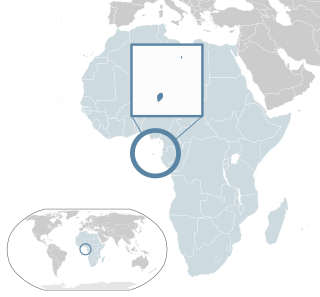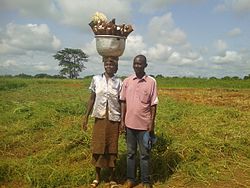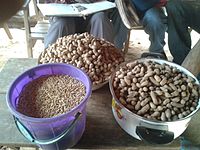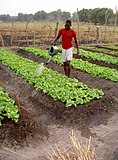
Fufu is a pounded meal found in West African cuisine. It is a Twi word that originates from the Akans in Ghana. The word has been expanded to include several variations of the pounded meal found in other African countries including Sierra Leone, Guinea, Liberia, Cote D'Ivoire, Burkina Faso, Benin, Togo, Nigeria, Cameroon, the Democratic Republic of Congo, the Central African Republic, the Republic of Congo, Angola and Gabon. It also includes variations in the Greater Antilles, where African culinary influence is high.
African cuisine is a staple of the continent's culture, and its history is entwined with the story of the native people of Africa. The foods that native Africans eat have been influenced by their religions, as well as by their climates and lifestyles. The first Africans to inhabit the continent were hunter-gatherers who ate what they could find in nature. As agriculture became more common in Africa, so did agriculture-based diets.

Ugandan cuisine consists of traditional and modern cooking styles, practices, foods and dishes in Uganda, with English, Arab, and Asian influences.

The cuisine of the Democratic Republic of the Congo and the Republic of the Congo varies widely, representing the food of indigenous people. Cassava, fufu, rice, plantain and potatoes are generally the staple foods eaten with other side dishes.

Ghanaian cuisine refers to the meals of the Ghanaian people. The main dishes of Ghana are centered around starchy staple foods, accompanied by either sauce or soup as well as a source of protein. The primary ingredients for the vast majority of soups and stews are tomatoes, hot peppers, and onions. As a result of these main ingredients, most Ghanaian soups and stews appear red or orange.

Peanut stew or groundnut stew, also known as maafe, sauce d'arachide (French) or tigadèguèna is a stew that is a staple food in Western Africa. It originates from the Mandinka and Bambara people of Mali.
Sierra Leonean cuisine consists of the cooking traditions and practices from Sierra Leone. It follows the traditions of other West African cuisines. The country has 16 tribal ethnic groups.

West African cuisine encompasses a diverse range of foods that are split between its 16 countries. In West Africa, many families grow and raise their own food, and within each there is a division of labor. Indigenous foods consist of a number of plant species and animals, and are important to those whose lifestyle depends on farming and hunting.

Nigerian cuisine consists of dishes or food items from the hundreds of Native African ethnic groups that comprises Nigeria. Like other West African cuisines, it uses spices and herbs with palm oil or groundnut oil to create deeply flavored sauces and soups.

Burkinabé cuisine, the cuisine of Burkina Faso, is similar to the cuisines in many parts of West Africa, and is based on staple foods of sorghum, millet, rice, fonio, maize, peanuts, potatoes, beans, yams and okra. Rice, maize and millet are the most commonly eaten grains. Grilled meat is common, particularly mutton, goat, beef and fish.

Beninese cuisine involves many fresh meals served with a variety of sauces. Meat is usually quite expensive, and meals are generally light on meat and generous on vegetable fat.

Ivorian cuisine is the traditional cuisine of Côte d'Ivoire, or the Ivory Coast, and is based on tubers, grains, pig, chicken, seafood, fish, fresh fruits, vegetables and spices. It is very similar to that of neighboring countries in West Africa. Common staple foods include grains and tubers. Côte d'Ivoire is one of the largest cocoa producers in the world and also produces palm oil and coffee.

Chadian cuisine is the cooking traditions, practices, foods and dishes associated with the Republic of Chad. Chadians use a medium variety of grains, vegetables, fruits and meats. Commonly consumed grains include millet, sorghum, and rice as staple foods. Commonly eaten vegetables include okra and cassava. A variety of fruits are also eaten. Meats include mutton, chicken, pork, goat, fish, lamb and beef. The day's main meal is typically consumed in the evening on a large communal plate, with men and women usually eating in separate areas. This meal is typically served on the ground upon a mat, with people sitting and eating around it.

Gabonese cuisine is the cooking traditions, practices, foods and dishes associated with Gabon, a sovereign state on the west coast of Central Africa. French cuisine is prevalent as a notable influence, and in larger cities various French specialties are available. In rural areas, food staples, such as cassava, rice and yams, are commonly used.

Togolese cuisine is the cuisine of the Togolese Republic, a country in Western Africa. Staple foods in Togolese cuisine include maize, rice, millet, cassava, yam, plantain and beans. Maize is the most commonly consumed food in the Togolese Republic. Fish is a significant source of protein. People in Togo tend to eat at home, but there are also restaurants and food stalls.

Angolan cuisine has many dishes popular among nationals and foreigners, including funge, mufete, calulu, moamba de galinha, moamba de ginguba, kissaca, and mukua sorbet.

Guinean cuisine includes traditional Guinean dishes such as fou fou, boiled mango, fried plantains, patates and pumpkin pie.

Liberian cuisine refers to the cuisine of Liberia. It is centered on the consumption of rice, cassava, plantain, yam, tropical fruits and vegetables, as well as fish, meat, and more.

Santomean cuisine comprises the cuisine, dishes and foods of São Tomé and Príncipe, a Portuguese-speaking island nation in the Gulf of Guinea, off the western equatorial coast of Central Africa. The country consists of two archipelagos around the two main islands: São Tomé and Príncipe, located about 140 kilometres (87 mi) apart and about 250 and 225 kilometres, respectively, off the northwestern coast of Gabon.






























